Last updated on May 16th, 2023
The ostrich is the largest living bird. Adult males can stand nine feet tall, with half of their height due to their long necks. They can weigh over 300 pounds, making them too heavy to fly with their wings. Hence, ostriches learned to live on land and adapt to their limited mobility. They thrive in the open country in Africa, evading powerful predators, managing extreme heat, and consuming anything the land can offer. Read on to learn interesting facts about ostriches.
Evolution
1. Birdlike dinosaurs once roamed Mississippi 85 million years ago. These ornithomimosaurs or bird mimics resemble modern ostriches. They had small skulls, large eyes, toothless beaks, and slender necks. However, they also had long tails and clawed hands.
2. The alleged discovery of collagen samples from Montana T-rex bones fueled dreams of DNA extraction and dinosaur cloning. However, the Jurrasic revival seems unlikely. Further studies found that the dinosaur samples matched ostrich collagen. Lab contamination may have influenced previous results.
3. While excavating for a new highway in Crimea, a cave network emerged containing ancient fossils. Among them was the femur of a land-based bird from the last ice age. Two million years ago, this super ostrich stood 11 feet tall and weighed almost 1,000 pounds, making it as big as a polar bear.
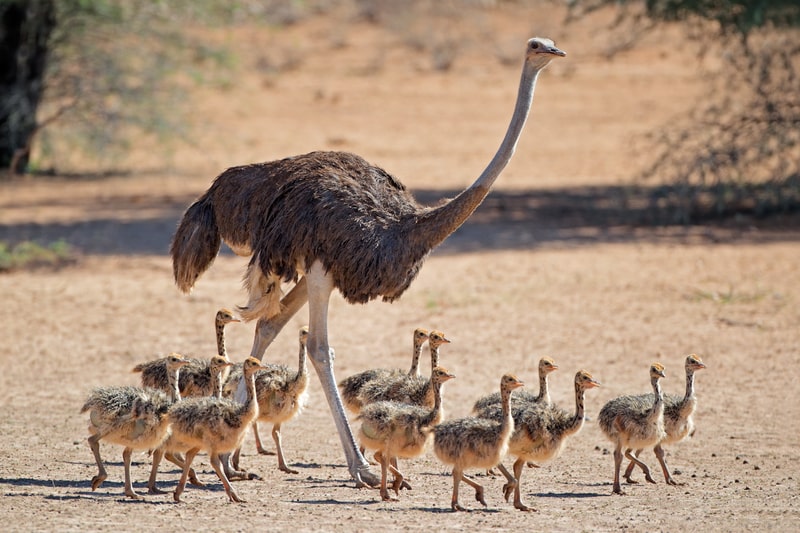
4. An old theory states that flightless birds lived in the supercontinent Pangea, and its breakup 100 million years ago resulted in evolutionary quirks among emus, ostriches, moas, and kiwis. New evidence suggests that birds flew to each continent much later. They lost their ability to fly independently.
5. Ostrich ancestors likely originated in the Northern Hemisphere 40 million years ago, with many bones found around Mongolia. The crane-like birds evolved into the modern ostrich in the Central Asian steppes before colonizing Africa 20 million years ago.
Physiology
6. Ostriches have fewer red blood cells than humans. They only have 40% of our RBC count per unit volume, although their cells are three times larger. Their oxygen affinity is lower because of differences in hemoglobin configuration.
7. The ostrich has a smaller surface area-to-volume ratio than other birds. It helps them reduce the rate of dehydration from evaporative water loss, which is crucial in dry and hot environments. After all, they can’t fly away to escape the heat.
8. Ostriches have long colons stretching up to 43 feet. These aid in water and nutrient absorption so they can make the most of the available food in barren lands. They produce dry feces like other desert dwellers.
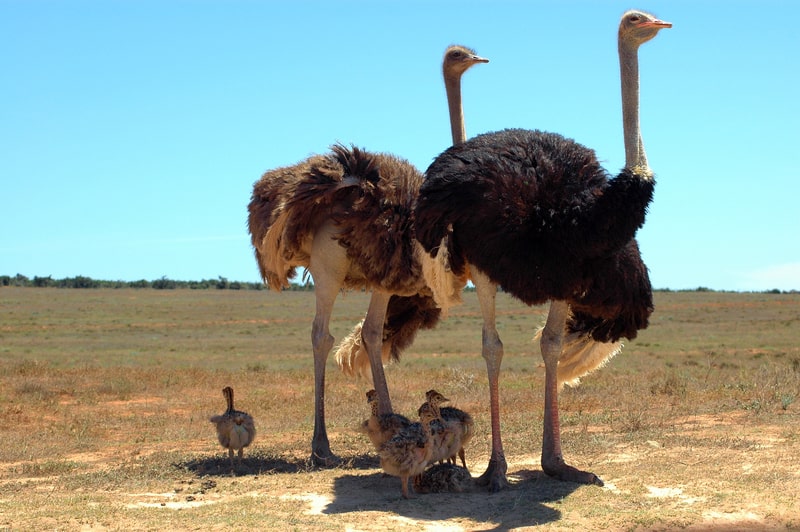
9. Ostrich kidneys are large. These help them drink massive amounts of water and excrete concentrated urine. Instead of a bladder, they store the liquid in a dilated ureter pouch until secretion.
10. About 68% of adult ostrich body mass is water. The estimate is 84% in month-old chicks, the difference resulting from changes in body fat mass. Fatty tissue has less water than lean tissue.
11. Ostriches can metabolize fat into water and energy. However, it is unsustainable for long periods. These birds lose water at 2.3 liters per day, while metabolic production is only 0.5 liters.
12. An ostrich may expend more energy than small birds, but it is mostly because of its weight. Their bigger bodies have more muscles. Ostriches use less energy if you examine expenditure per unit mass.
13. It is easy to distinguish males and females. The former has predominantly black feathers, with a few white plumes on the tail and wings. Meanwhile, the latter has a brown coat and a slightly smaller body.
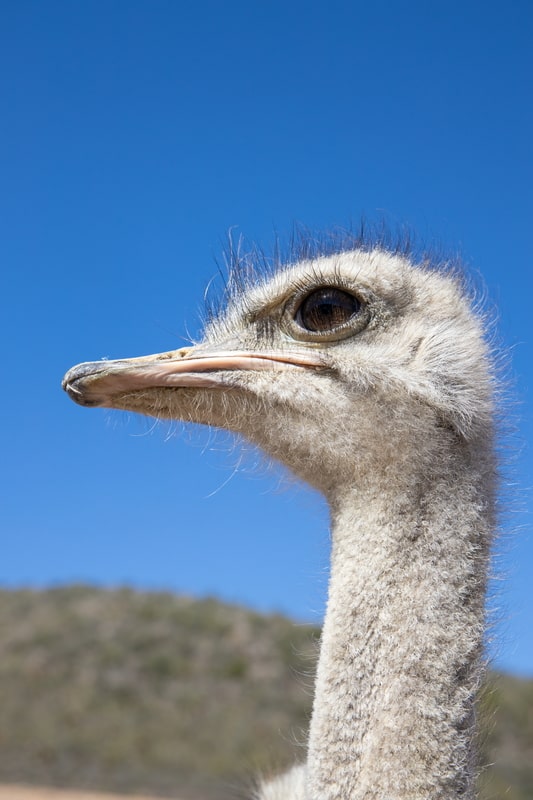
14. Ostriches have a small head, a short bill, and big brown eyes. The neck has light hair with a red and blue tint. The legs are bare, including the muscular thighs used extensively for defense.
15. Most birds have four toes, but ostriches have only two. These are large and powerful. The big toe looks and functions almost like a hoof. The emu, often mistaken for an ostrich, has three toes on each foot.
Behaviors
16. Ostriches seek shade when temperatures shoot up. They also fluff their feathers as a form of thermal regulation. By contracting their muscles, they raise their feathers to increase airflow near the skin.
17. The opposite happens when it turns cold. Ostriches perform feather flattening to conserve body heat using their natural insulation. They also cover their bare legs and shiver to generate more body heat.
18. Ostriches have no sweat glands. They pant when subjected to heat stress. Panting improves evaporative heat loss, with the dissipation rate changing in proportion to the ambient temperature. They always match their environment.
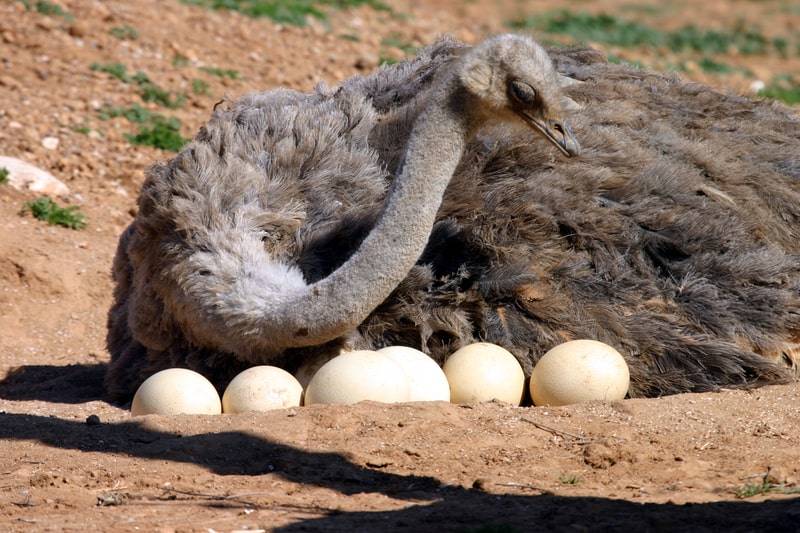
19. The ostrich prefers a plant-based diet. It eats seeds, grass, fruits, shrubs, and flowers. It may eat small reptiles, insects, and invertebrates whenever available. It also feeds on carcasses left by predators.
20. Ostriches can’t fly, but they can run. Their long legs propel them to up to 70 kph – the fastest bird on land. They leave elite athletes in the dust in foot races. They can even chase road cyclists on long descents.
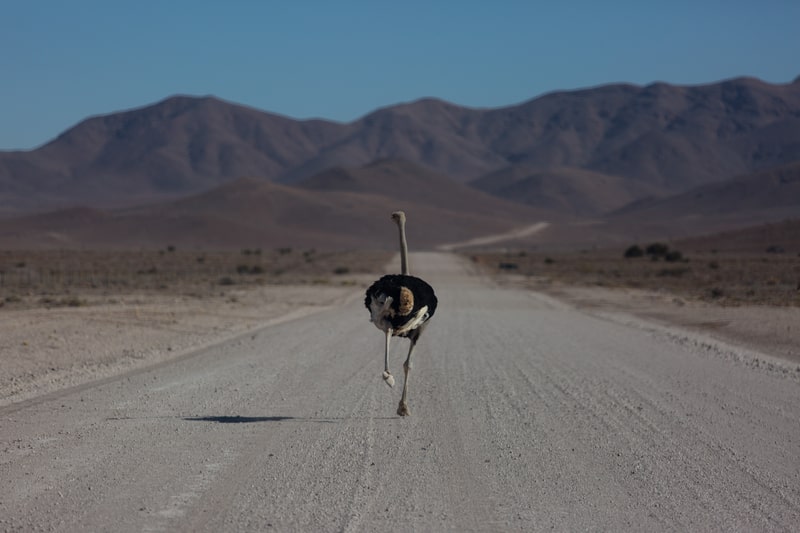
21. Many animals prey on ostriches in the wild, so the latter developed multiple defensive strategies. They avoid confrontations as much as possible, using their excellent eyesight to spot threats and fast legs to outrun predators.
22. Sometimes ostriches need to fight. Predators use stealth to ambush these unsuspecting birds and cut off their escape routes. In these close encounters, the powerful legs of an ostrich can deliver fatal kicks. They can kill lions, hyenas, and even humans while protecting their chicks.
23. Ostriches may forage with friendly mammals like zebras, antelopes, and wildebeests. These companions make it easier to detect the presence of nearby predators, giving the birds ample time to plot their escape.
24. Most ostriches spend the winter months alone or in pairs. They form larger nomadic groups during the breeding season, with 5 to 100 birds per herd. The top hen leads the group.

25. According to a popular myth, the ostrich buries its head in the sand when avoiding danger. This behavior is misunderstood. They swallow sand and pebbles for better digestion. They may also lie low to avoid predators and rotate eggs in the sand during incubation.
Reproduction
26. Female ostriches mature faster than males. They start mating once they reach 2 to 4 years of age and reproduce several times across their lifespan. The long mating season begins in March and ends in September.
27. Males inflate their necks to make a booming sound. This mating call attempts to attract females and defend their territory against rivals. Successful males can mate with two to seven females in a group. However, he can only form a bond with one of them.
28. Males perform mating rituals. They raise their feathers to impress their audience and beat their wings alternately as if in a dance. They also prance about and bend their neck from side to side. Their necks and legs develop a red shade due to the flush of blood.
29. Some ostrich pairs prefer privacy, with the male driving away intruders to the mating area. They may graze until they achieve synchrony. He will flap his wings and poke the ground. She will run around him in a circle before dropping for copulation.
30. Captive ostriches may develop strong bonds with their human caretakers if these people raised them from birth. When it is time to mate, these birds may perform courtship rituals for their keepers instead of other ostriches.
Eggs
31. The ostrich lays the largest eggs among existing birds. Throughout history, the elephant birds of Madagascar and the giant moa of New Zealand laid larger eggs, but these are now extinct.

32. On average, ostrich eggs are about 6 inches long and 5 inches wide. Tipping the scales at 3 pounds, they are 20 times heavier than chicken eggs. Despite these proportions, they are only 1-4% the size of adult females.
33. The cream-colored eggs have glossy shells with small pits. They require round-the-clock incubation. Females take the day shift, with their gray feathers blending with the sand. Males guard them at night, with their black coats disappearing in the darkness.
34. Dominant females choose the nesting site. They lay their eggs first, placing these in the middle, away from predators. Other females in the herd follow. The communal nest is a ground pit about 24 inches deep and 10 feet wide.
35. Incubation lasts up to 45 days. Males defend the hatchlings and teach them to feed. Despite parental protection, less than 10% of nests escape predators, and only 15% of the surviving chicks are still around a year after.

Culture
36. The Egyptian goddess of truth and justice, Ma’at, decided who could enter the afterlife by weighing the hearts of men against an ostrich feather. She granted passage to people whose hearts were lighter.
37. Servants kept pharaohs cool with fans made from ostrich feathers mounted on long poles. Egyptian soldiers also wore these feathers in their hair, though the practice later became exclusive to royalty.
38. In the Kalahari desert, hunter-gatherers used ostrich eggshells as water containers. They punched a hole, removed the contents, and filled them with liquids. They also used bits and pieces for jewelry production. The practice continues among African bushmen.
39. In late antiquity, Christians of Eastern Europe hung decorated ostrich eggs on oil lamp chains. It prevented mice from climbing down to consume the oil. It also reminded them to focus on God during prayer, just as the female birds never strayed from their eggs.
40. After conquering Milan, Francis I of France compelled the nobles to wear berets topped with plumes. In 1521, the fashion trend spread to the rest of Europe, with men putting feathers in their caps to underscore their fame and wealth. Even the Ottoman Empire was not immune to the craze.
. . . continue reading on the next page
